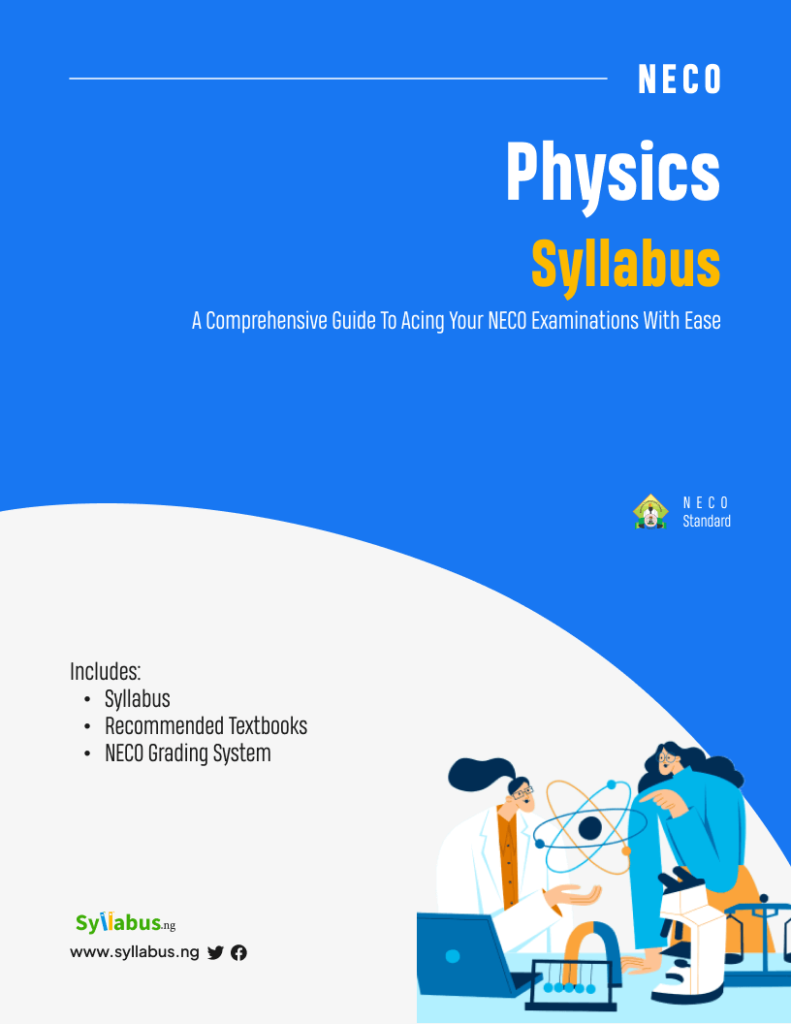NECO Physics Syllabus
Are you writing Physics in your NECO O’level exams? Download the recommended commerce syllabus to excel in your exams.

Home » NECO Syllabus » NECO Physics SyllabusAbout NECO Physics Studies Syllabus
This NECO physics exam syllabus will be your guide towards the success of your examination. We’ve crafted this syllabus with a focus on concepts and applications, designed to give you a solid foundation in your upcoming examination.
This syllabus is fully stocked to aid your preparations for your NECO Physics exam. I can bet that if you religiously study and practice the outlines in the syllabus together with past questions and some online resources you will pass your exam in flying colors.
Now, let’s talk about assessment objectives. The examiners are all about testing what you know and how you can apply it. From acquiring knowledge and understanding to handling information and problem-solving. They’ve got a variety of activities lined up to put your physics skills to the test.
Marking Guide & Sections
PAPER 1
Paper 1 is where you kick off the exam, it consists of 50 multiple-choice questions that will earn you 1 mark for each question and the total mark for the 50 questions will earn you 50 marks.
PAPER 2
Paper 2 consists of two sections, Sections A and B lasting for 1 ½ hours and it’s worth 60 marks.
Section A
In section A, you’ll face seven short-structured questions, and you will need to answer any five of them. It’s all about showing off your knowledge and skills in bite-sized chunks, with a total of 15 marks up for grabs.
Section B
Then, in section B, you will face five essay questions, but here’s the catch, you only need to answer three of them. That gives you a bit of flexibility to showcase your writing prowess and earn yourself a whopping 45 marks. So get ready to put pen to paper and let those ideas flow!
PAPER 3
Paper 3 is the practical section of the NECO Physics exam, for school candidates, it’s all about putting your practical skills to the test. Private candidates, don’t worry, the examiners have something for you too, as an alternative to practical work paper. You will have three questions to choose from, and you will need to answer any two of them in 2 ¼ hours. It’s your chance to roll up your sleeves and have some fun, all while earning yourself a cool 50 marks.
Download NECO Physics Syllabus

Best candidates excel because they study smart and hard. Know what’s expected of you.
Download the NECO recommended Physics syllabus.
The NECO Physics Syllabus
| NECO PHYSICS SYLLABUS | ||
| SN | TOPICS | OBJECTIVES |
| 1 | Concepts of matter | |
| 2 | Fundamental and derived quantities and units | 2.1 Fundamental quantities and units 2.2 Derived quantities and units |
| 3 | Position, distance and displacement | 3.1 Concept of position as a location of point-rectangular coordinates 3.2 Measurement of distance 3.3 Concept of direction as a way of locating a point –bearing 3.4 Distinction between distance and displacement |
| 4 | Mass and weight | 4.1 Distinction between mass and weight |
| 5 | Time | 5.1 Concept of time as interval between physical events 5.2 Measurement of time |
| 6 | Fluid at rest | 6.1 Volume, density and relative density 6.2 Pressure in fluids 6.3 Equilibrium of bodies |
| 7 | Motion | 7.1 Types of motion: Random, rectilinear, translational, Rotational, circular, orbital, spin, Oscillatory 7.2 Relative motion 7.3 Cause of motion 7.4 Types of force 7.5 Solid friction 7.6 Viscosity (friction in fluids) 7.7 Simple ideas of circular motion |
| 8 | Speed and velocity | 8.1 Concept of speed as change of distance with time 8.2 Concept of velocity as change of displacement with time 8.3 Uniform/non-uniform speed/velocity 8.4 Distance/displacement-time graph |
| 9 | Rectilinear acceleration | 9.1 Concept of Acceleration/deceleration as increase/decrease in velocity with time 9.2 Uniform/non-uniform acceleration 9.3 Velocity-time graph 9.4 Equations of motion with constant acceleration 9.5 Motion under gravity as a special case |
| 10 | Scalars and vectors | 10.1 Concept of scalars as physical quantities with magnitude and no direction 10.2 Concept of vectors as physical quantities with both magnitude and direction 10.3 Vector representation 10.4 Addition of vectors 10.5 Resolution of vectors 10.6 Resultant velocity using vector representation |
| 11 | Equilibrium of forces | 11.1 Principle of moments 11.2 Conditions for equilibrium of rigid bodies under the action of parallel and non-parallel forces 11.3 Centre of gravity and stability |
| 12 | Simple harmonic motion | 12.1 Illustration, explanation and definition of simple harmonic motion (S.H.M) 12.2 Speed and acceleration of S.H.M 12.3 Energy of S.H.M 12.5 Forced vibration and resonance |
| 13 | Newton’s laws of motion | 13.1 First Law: Inertia of rest and inertia of motion 13.2 Second Law: Force, acceleration, momentum and impulse 13.3 Third Law: Action and reaction |
| 14 | Energy | 14.1 Forms of energy 14.2 World energy resources 14.3 Conservation of energy |
| 15 | Work, Energy and Power | 15.1 Concept of work as a measure of energy transfer 15.2 Concept of energy as capability to do work 15.3 Work done in a gravitational field 15.4 Types of mechanical energy 15.5 Conservation of mechanical energy 15.6 Concept of power as time rate of doing work 15.7 Application of mechanical energy machines |
| 16 | Heat Energy | 16.1 Temperature and its measurement 16.2 Effects of heat on matter 16.3 Thermal expansion – Linear, area and volume expansivity 16.4 Heat transfer – Condition, convection and radiation 16.5 The gas laws-Boyle’s law Charles’ law, pressure law and general gas law 16.6 Measurement of heat energy 16.7 Latent heat 16.8 Evaporation and boiling 16.9 Vapour and vapour pressure 16.10 Humidity, relative humidity and dew point 16.11 Humidity and the weather |
| 17 | Production and propagation of waves | 17.1 Production and propagation of mechanical waves 17.2 Pulsating system: Energy transmitted with definite speed, frequency and wavelength 17.3 Waveform 17.4 Mathematical relationship connecting frequency (f), wavelength(), period (T) and velocity (v) |
| 18 | Types of waves | 18.1 Transverse and longitudinal 18.2 Mathematical representation of wave motion |
| 19 | Properties of waves | Reflection, refraction, diffraction,Interference, superposition of progressive waves producing standing stationary waves |
| 20 | Light waves | 20.1 Sources of light 20.2 Rectilinear propagation of light 20.3 Reflection of light at plane surface: plane mirror 20.4 Reflection of light at curved surfaces: concave and convex mirrors 20.5 Refraction of light at plane surfaces: rectangular glass prism (block) and triangular prism 20.6 Refraction of light at curved surfaces: Converging and diverging lenses 20.7 Application of lenses in optical instruments 20.8 Dispersion of white light by a triangular glass prism |
| 21 | Electromagnetic waves: Types of radiation in electromagnetic Spectrum | |
| 22 | Sound Wave | 22.1 Sources of sound 22.2 Transmission of sound waves 22.3 Speed of sound in solid, liquid and air 22.4 Echoes and reverberation 22.5 Noise and music 22.6 Characteristics of sound 22.7 Vibration in strings 22.8 Forced vibration 22.9 Vibration of air in pipe – open and closed pipes |
| 23 | Description property of fields | 23.1 Concept of fields: Gravitational, electric and Magnetic 23.2 Properties of a force field |
| 24 | Gravitational field | 24.1 Acceleration due to gravity, (g) 24.2 Gravitational force between two masses 24.3 Gravitational potential and escape velocity |
| 25 | Electric Field | 25.1 Electrostatics 25.2 Current electricity |
| 26 | Magnetic field | 26.1 Properties of magnets and magnetic materials 26.2 Magnetization and demagnetization 26.3 Concept of magnetic field 26.4 Magnetic force 26.5 Use of electromagnets 26.6 The earth’s magnetic field 26.7 Magnetic force on a moving charged particle |
| 27 | Electromagnetic field | 27.1 Concept of electromagnetic field 27.2 Electromagnetic induction 27.3 Inductance 27.4 Eddy currents 27.5 Power transmission and distribution |
| 28 | Simple a.c. circuits | 28.1 Graphical representation of e.m.f and current in an a.c. circuit 28.2 Peak and rms values 28.3 Series circuit containing resistor, inductor and capacitor 28.4 Reactance and impedance 28.5 Vector diagrams 28.6 Resonance in an a.c, circuit 28.7 Power in an a.c. circuit |
| 29 | Structure of the atom | 29.1 Models of the atom 29.2 Energy quantization 29.3 Photoelectric effect 29.4 Thermionic emission 29.5 X-rays |
| 30 | Structure of the nucleus | 30.1 Composition of the nucleus |
| 31 | Wave-particle paradox | 31.1 Electron diffraction 31.2 Duality of matter |
Recommended NECO Physics Textbooks
1. Ike, E. E (2014) Essential Principles of Physics, Jos ENIC Publishers.
2. Ike, E. E (2014) Numerical Problems and Solutions in Physics, Jos, ENIC Publishers.
3. Nelson, M (1977) Fundamentals of Physics, Great Britain: Hart Davis Education.
4. Nelson, M and Parker … (1989) Advanced Level Physics (Sixth Edition), Heinemann.
5. Okeke, P. N and Anyakoha, M. W (2000) Senior Secondary School Physics, Lagos, Pacific Printers.
6. Olumuyionwa A. and Ogunkoya O. O (1992) Comprehensive Certificate Physics, Ibadan: University Press Plc.
All NECO Syllabus
Frequently Asked Questions About the NECO Physics Exams
The essay questions in Paper 2 are a chance to express your knowledge and writing skills. When approaching these questions, take a moment to read through all the options and choose the ones you feel most confident about. Then, plan your answers carefully, making sure to structure them clearly and provide plenty of examples to back up your points. Remember to keep an eye on the clock and leave yourself enough time to review your answers before submitting.
When preparing for the practical test, make sure you’re familiar with the equipment and procedures you’ll be using. Pay attention to detail and follow instructions carefully, making accurate observations and measurements along the way. And don’t forget to practice your problem-solving skills, you never know what challenges might come your way during the test.
Don’t panic, you’ve got options! If you come across a question that’s giving you trouble, take a deep breath and read it over carefully. Sometimes, just taking a moment to digest the question can make all the difference. If you’re still stuck, don’t hesitate to raise your hand and ask the invigilator for clarification. They’re there to help you, so don’t be shy about speaking up. Remember, it’s better to ask for help than to struggle in silence.
When studying for the NECO Physics exam, it’s important to focus on all the key topics outlined in the syllabus. This includes concepts like matter, motion, energy, waves, fields, Atomic and Nuclear Physics, and electronics. Make sure to allocate your study time wisely and give each topic the attention it deserves. And don’t forget to review any areas where you feel less confident,every bit of preparation counts.
Yes, you can! Calculators are generally permitted for use during the NECO Physics exam. However, it’s always a good idea to double-check the exam guidelines or ask your teacher for confirmation just to be sure. Remember to familiarize yourself with your calculator and its functions beforehand so you can use it effectively during the exam.
Improving your problem-solving skills is all about practice, practice, practice! Start by solving a variety of physics problems from past papers, textbooks, and online resources. Pay attention to the steps involved in solving each problem and try to understand the underlying concepts behind them. Don’t be afraid to challenge yourself with more difficult problems as you become more confident.
Marks for the practical test in Paper 3 are typically awarded based on the accuracy and completeness of your observations, measurements, and conclusions. Make sure to follow instructions carefully, record your data accurately, and present your findings clearly and logically. Pay attention to details like precision, accuracy, and units, and don’t forget to include any necessary calculations or graphs to support your conclusions. With careful preparation and attention to detail, you’ll be sure to earn those marks.
Download NECO Physics Syllabus

Best candidates excel because they study smart and hard. Know what’s expected of you.
Download the NECO recommended Physics syllabus.











